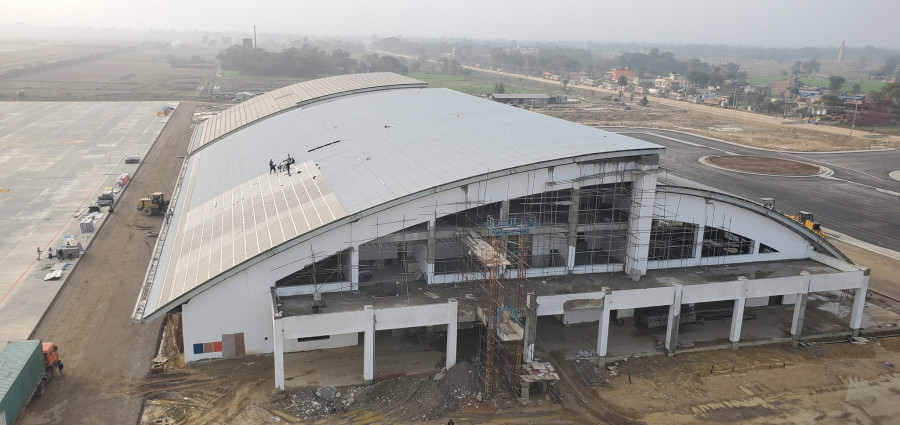National
Governmental red tape holds up plan to operate Bhairahawa solely on solar power
A disagreement over land lease rate between the Nepal Electricity Authority and the Civil Aviation Authority means that Bhairahawa might not get its solar plant.
Sangam Prasain
Nepal may potentially lose out on a Rs1 billion grant as a dispute over land lease rates could spoil the plan to make Nepal’s second international airport in Bhairahawa a fully solar-powered facility.
The Asian Development Bank, which is funding the airport, has set aside Rs1 billion to install solar panels that will produce around 10 megawatts to operate the airport on solar power alone. Any surplus power will be fed into the national grid. The solar farm was planned for 52 bighas of land in Bhairahawa belonging to the Civil Aviation Authority of Nepal.
As per the airport service charge regulation, based on the Tribhuvan International Airport service charge regulation, the land lease fee for civil aviation or business purposes is Rs600 per square metre annually. The same fee for leasing land for agricultural purposes is Rs1,000 per ropani or 508.74 sq m per year.
Leasing 52 bighas of land under the civil aviation category would cost the Nepal Electricity Authority, which is the executing agency for the solar project, more than Rs200 million annually.
“It’s too expensive,” said Manoj Silwal, chief of the Project Management Directorate of the Nepal Electricity Authority. “The cost of operation will be too high if we agree on the existing rate. It’s useless land but it’s too expensive.”
Gautam Buddha International Airport in Bhairahawa could become the world’s second fully solar-powered airport when it opens later this year in June, after India's Cochin International Airport, which earned the distinction in 2015.
The issue could be resolved via a Cabinet decision but officials at the Nepal Electricity Authority and the Asian Development Bank told the Post that the Tourism Ministry has yet to seriously pursue a resolution.
“We have frequently asked Tourism Minister Yogesh Bhattarai that the land lease rates be resolved soon to move ahead with the project,” said an Asian Development Bank official on condition of anonymity. “But we haven’t received any response from him, except for an assurance to support the project.”
Time is fast running out for the project, as it needs to be completed by 2020, said the official. The project is expected to take at least six months to complete.
Initially, the solar plan had set off an argument between the Civil Aviation Authority and the Nepal Electricity Authority over sharing the income generated from solar power.
Now that the income issue has been resolved, the land lease disagreement threatens to derail the project.
Officials said that it has been almost a year since talks started but they have reached nowhere.
“The issue doesn’t look to be settled any time soon. So we have decided to ask the potential developer of the project to find a different location on which to install the solar farm,” Silwal said. The bank’s grant will be used for viability gap funding in another solar project that would be of around 25 MW, he said.
The project moving elsewhere means that the electricity generated will need to be fed into the national grid first with more electricity, which defeats the purpose of operating the airport solely on solar power.
Pradeep Adhikari, chief of National Pride Projects at the Civil Aviation Authority of Nepal who also oversees the Bhairahawa Gautam Buddha International Airport, agreed that the fee is high and that the land is useless as well.
“But there’s nothing we can do about it as we need to abide by the airport service charge regulations,” said Adhikari.
However, the government can address the issue by taking it to the Cabinet.
“The government can also charge the solar farm under the farm category, which will bring down the leasing cost significantly. It can also be charged under the ‘other airports’ category, which is cheaper,” said the bank official. The lease rate for the ‘other airports’ category is a minimum of Rs100 per square metre.
Another source at the bank said that the bank may provide additional financing of Rs5 billion for Terminal 2, an international terminal project that may begin in 2020.
“At this time, a small grant may be allocated for the solar power project,” said the official.
In July last year, a team of energy and aviation officials had visited Malaysia to study the solar power system at Kuala Lumpur International Airport and concluded that the plan to make Bhairahawa airport a fully solar-powered airport was technically viable.
The team had concluded that installing a solar farm on the airport premises will not pose a risk to flight safety, handling or communications.
If the solar power plan goes through, the entire airport—from air traffic control, baggage claim and runway lights to ground control rooms and passenger terminals—will be powered by solar energy, a first for the country on an infrastructure of that size.




 12.12°C Kathmandu
12.12°C Kathmandu















